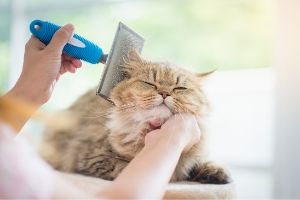Meow - it’s National Adopt a Cat Month! If you’ve ever adopted a pet, you know that it can be one of the most rewarding experiences for both you and your fur baby. As many adopters will tell you, it’s often a question of who saved whom, as these grateful animals bring us so much joy. If you’re considering adopting a kitten or cat, you obviously want your feline friend to be around for as long as possible. Thankfully, there are plenty of things you can do when it comes to cat wellness to keep your pet happy and healthy for a long time. We’ve rounded up some relatively easy and practical ways to raise a healthy cat and shared seven of them below.

1. Pay Attention to Diet and Thirst
The consensus among veterinarians these days is that high-quality wet food is the best for the health of your cat, as it’s most like what their diet would be like in the wild. If you have concerns about how this will affect your budget, a combination of wet cat food and kibble can work as well. The most important thing to consider is that you want to introduce wet food as early as possible, as cats can be quite finicky about texture. If you wait too long to introduce wet food into their diet, they might not eat it. As with all pets, you also want to be judicious about doling out cat treats so as to avoid the health issues that accompany obesity. Most importantly, keep in mind that cats cannot be vegetarians, even for short periods of time. The dry food is mostly carbohydrates, so it won’t contain enough meat and can lead to weight gain.
As this article from Health magazine notes, “today’s domestic cats evolved from desert-dwelling forefathers, and they don’t have the same thirst-drive as dogs. They need to get most of their water from food.” This is another reason why wet food is preferred. If you adopt an older cat, however, you need to watch out for signs of dehydration, which can be panting, sunken eyes, and lethargy.
2. Give Your Cat a Safe Space
We’ve all seen the memes about cat personalities vs. dog personalities and, even if your cat is on the more social side, they still like to have a place to call their own to retreat to when they want. You also want to make sure that the area where you keep your litter box is safe, clean, and doesn’t create any kind of stress for your favorite feline. As in nature, cats like to be able to see around them when they are going to the bathroom to avoid becoming vulnerable, so make sure their litter box gives them this. Do not get a litter box with a top, as tempting as that may be for you. There should also be one litter box per kitty, so if you have more than one kitty, it’s important that they each have their own. And what you might not realize is that cats have a definite preference when it comes to kitty litter, so you’ll likely have to experiment with brands. Lastly, if the cat you’re adopting is the first one in your home, you’ll want to get a “cat’s eye view” of your home in order to remove anything potentially hazardous.

3. Don’t Go Cat Crazy
While some owners can make multiple cats work, more than 2 cats can get complicated. If you add any more than that, territorial behaviors such as eliminating outside the litter box can start. However, we must also note that, if your cat does start going to the bathroom outside the litter box, you should talk to a veterinarian. Don’t just assume that this is a behavioral thing, as it can also be a sign of a urinary tract infection or another physical ailment.
4. Enrich Your Cat’s Environment
The vast majority of cats these days are indoor cats, as there are far too many dangers that lurk outside in most areas. Keeping your cat indoors will save you money at the vet and will almost undoubtedly help your cat to live longer. However, this doesn’t equate to cat happiness. Felines are natural hunters, and when they are outside they’re chasing, smelling, touching, and exploring their surroundings. So if you keep them indoors, you need to enrich their environment to keep them active and stimulated.

Experiment with toys, as all cats are different. Some love laser pens while others love the fishing lures with the toy at the end. And most importantly, give them an outlet for their scratching, or your furniture and curtains will pay the price. Put a scratching post in a couple of high-traffic areas in your house to allow for ample access. If your cat is resistant and still getting into mischief, you can cover the scratching posts in catnip to make them more desirable to your playful pal.
5. Make Your Vet Visit a Priority
Whether you adopt a cat or a kitten, make sure a visit to the vet is at the top of your list of priorities. You need to ensure proper cat vaccinations and that your cat’s been tested for FeLV (feline leukemia), to get them on flea and tick preventative, and that all cat deworming protocols are being followed. Your vet wants to work with you to ensure you get your cat on a solid path to wellness.

6. Brush Your Cat Often
We know it’s a lot to ask, but brushing your cat daily will reduce the risk of hairballs developing in their digestive tract. It can be too easy to lull yourself into a place of complacency if your cat is a good groomer. This still won’t help them to remove the loose hair that can cause hairballs. Make the brush your cat’s best friend instead of their worst enemy by associating brushing time with something positive, such as getting a treat.
7. Spay or Neuter Your Cat
Any adoption agency worth its salt should take care of your cat spay or neuter for you, which is a huge benefit of cat adoption. Not only does spaying/neutering control the cat population and the ensuing high euthanasia rates associated with overpopulation, but it can also prevent a cat from getting very uncomfortable by going into heat.
Happy National Adopt a Cat Month! If you’re on the fence about whether a cat would be a welcome addition in your home, please feel free to give us a call. We want your cat adoption experience to be just purrrrrfect.

